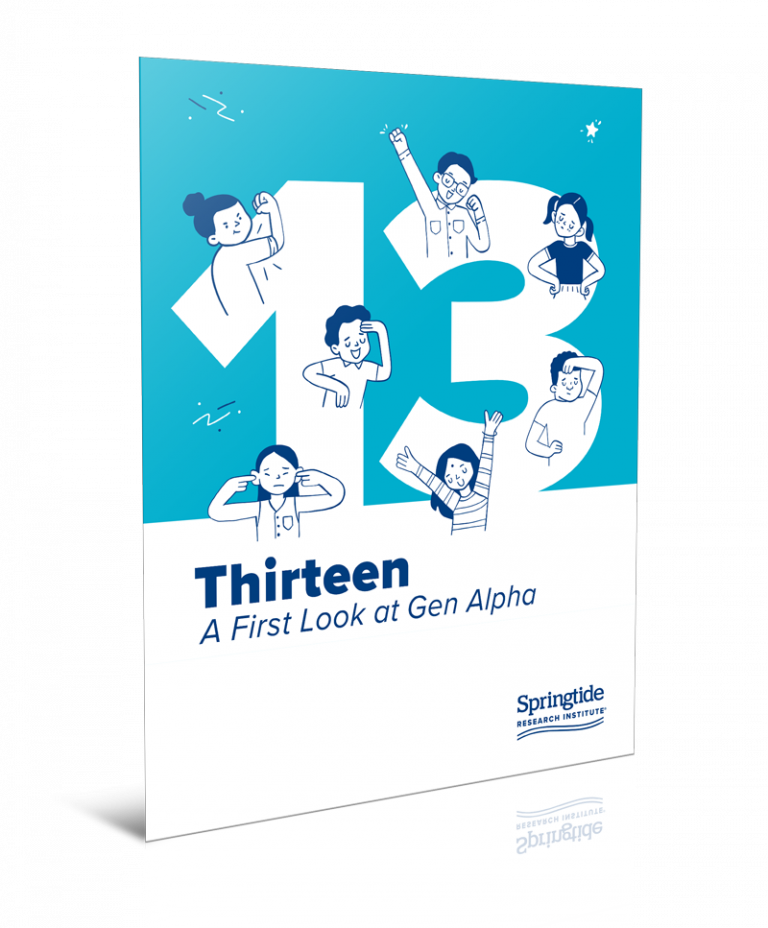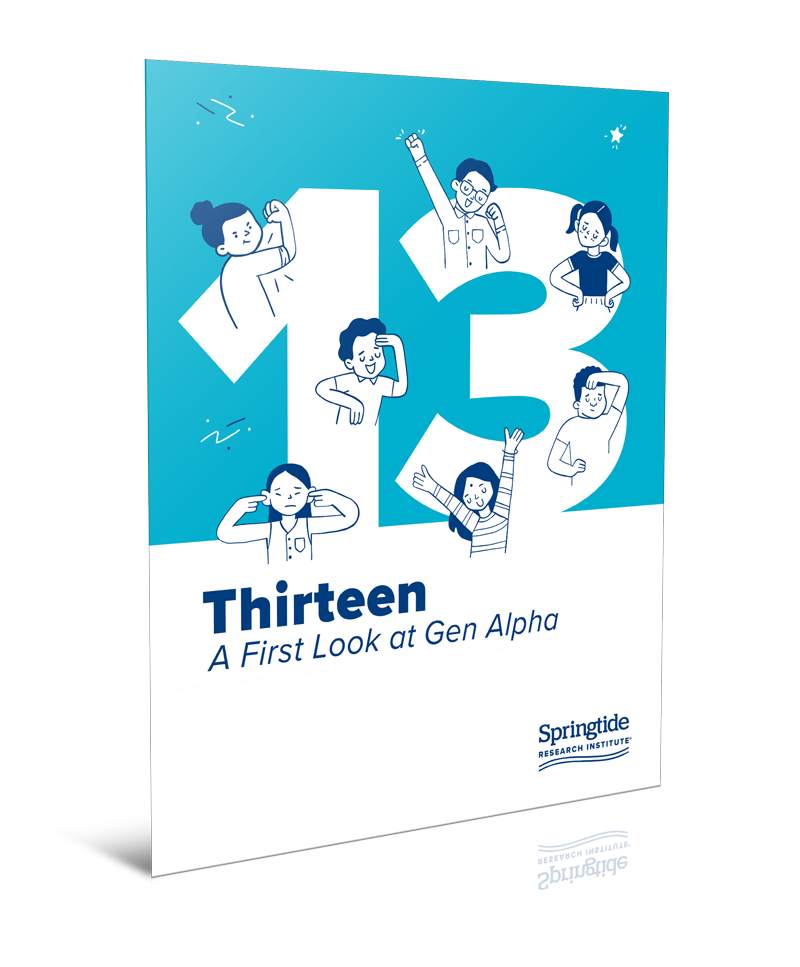New Data from our Study on Gen Alpha
Learn key characteristics, trends, and demographics about this new generation with data on Gen Alpha and 13-year-olds
The oldest members of Generation Alpha—born in 2010 or after—are now entering their teenage years. Teenagers and young adults now span from Gen A to Gen Z.
Springtide Research Institute conducted a study of 13-year-olds in the US—the oldest members of “Generation Alpha.” We focused on finding out how Generation Alpha differs from Generation Z and other generations.
In our free report, we share what we learned from asking 13-year-olds in 2024 how they see themselves and others. We invited their thoughts on religion, politics, and technology; their experiences of the COVID-19 pandemic; their feedback on their mental health and well-being; and more.
We’re learning about Gen Alpha. We started by asking—and listening to—13-year-olds.
Who is Gen Alpha?
Younger than Gen Z, members of Gen Alpha were born in 2010 or after, now ranging from babies to new teenagers. Where does the name Gen Alpha come from? The first letter of the Greek alphabet represents the end of previous naming structures (Gen X, Y and Z) and the beginning of a new cycle.
Find out more about this latest generation on these popular blog posts and download our new research report on 13-year-olds, the first age group to enter our dataset.
Characteristics of Gen Alpha
Generation Alpha is growing up in an age of technological advancement, as “digital natives.” Worries about screen time are pervasive, especially after the pandemic.
Patterns we see in Gen Z, the generation older than Gen Alpha, may be seen in Gen Alpha, as well. Gen Z was more racially diverse than any previous generation. Now, Gen Alpha is set to become the most racially diverse generation. This may shape their friendships, levels of empathy, and understandings of race, gender, sexual orientation, and more.
The State of Religion & Young People 2022 found that nearly half of young people in Gen Z reported being moderately or extremely depressed (47%). As for Gen Alpha’s mental health, previous research has hinted at heightened rates of anxiety and depression, due in part to the effects of the COVID-19 pandemic.
13 Data-based insights about being 13 and part of Gen Alpha
-
Age matters most to self-identity.
Given a list of options including gender, race, family status, and more, 13-year-olds most commonly choose age-group as the identity most important to them. They describe life at 13 as fun, exciting, awkward, and hard—sometimes all at once.
-
Friendships—often racially diverse—feel central.
A large majority of young teens agree that their friendships feel supportive and rewarding. Most 13-year-olds say that their closest friends include someone whose racial identity differs from theirs. Primarily because “my friends use it,” nearly all 13-year-olds are on social media. Most feel as though COVID-19 did not have a negative impact on their relationships with friends.
-
Smartphones feel “addictive,” and parents monitor use.
Nearly all 13-year-olds say that they have a smartphone, and nearly half agree that they are “addicted” to it. Most spend at least a few hours on their phone daily. Teens commonly have access to laptops, tablets, and gaming consoles too. More than half of 13-year-olds say that they have to ask their parents’ permission to use apps or sites. They also report that their parents limit screen time and monitor online activity.
-
COVID-19’s impact wasn’t all negative.
Three-quarters of 13-year-olds say that COVID-19 had a positive, mixed, or neutral overall impact on their lives, compared to one-quarter who evaluate it as having negatively impacted their lives in general. Its impact on family relationships is evaluated especially positively.
-
Inequality meant that COVID-19 was experienced unevenly.
For 13-year-olds in lower-income households, the impact of the COVID-19 pandemic felt more negative than positive. Assessments of the impact of COVID-19 in all domains of life (relationships, physical and mental health, education, and in general) are more neutral or positive among those in households with more financial resources.
-
Racial and ethnic identities frame outlooks.
Race and ethnicity feel especially important to Black, Indigenous, People of Color (BIPOC) 13-year-olds’ identity, a third of whom say they have felt discriminated against because of their race or ethnicity. BIPOC 13-year-olds are more likely than their white counterparts to feel as though their race or ethnicity will worsen their opportunities in life. White teens, by comparison, are more likely to feel as though their racial identity will better their opportunities.
-
Religion and spirituality are a common part of identity and life.
Many 13-year-olds care about religion and spirituality. Large majorities identify as at least slightly spiritual, slightly religious, or both. Most live in homes where religion and spirituality come up in conversation at least sometimes. Teens who believe in a higher power and who see religion as personally important are less likely to report feeling unhappy or lonely over the past month.
-
Political identities are yet to be formed.
Thirteen-year-olds are more likely to say “I don’t know” than to identify with a specific political party (e.g., Democrat or Republican) or ideological position (e.g., conservative or liberal).
-
Climate change haunts futures.
Six in ten 13-year-olds worry about the effects of climate change at least sometimes. Nearly half expect that their lives will turn out differently than their parents’ lives because of it. A large majority sees efforts to reduce the negative effects of climate change as good for society.
-
Artificial Intelligence sparks familiarity and creativity.
Nearly all young teens have heard or read about artificial intelligence (AI), and a little under half have used it. Most enlist it for schoolwork, yet 13-year-olds also name information-seeking, artistic expression, gaming, and companionship among the reasons they look to AI.
-
Part of the most racially diverse generation, Gen Alpha 13-year-olds tend to see increased racial and ethnic diversity in the US as a good thing.
Far fewer believe that an increase in racial and ethnic diversity is a bad thing. Many 13-year-olds attend racially diverse schools and befriend racially diverse peers.
-
Loneliness, worry, and anxiety happen.
Though far from dominating life, feelings of loneliness crop up at least sometimes over a four-week period for four in ten 13-year-olds. Half feel worried or anxious at least sometimes during the same period.
-
For a good opportunity, feeling nervous or scared is okay.
Most 13-year-olds say that they will do something that makes them feel nervous or scared if it is for a good opportunity, rather than miss out.
Download the full report for FREE
Download Thirteen: A First Look at Gen Alpha Report for FREE
Find out how young people are finding the sacred. . . and how it impacts their mental health
The State of Religion & Young People 2023: Exploring the Sacred, uncovers how young people have been encountering and exploring concepts of sacredness and belonging in unexpected ways.
The State of Religion & Young People 2023: Exploring the Sacred, uncovers how young people have been encountering and exploring concepts of sacredness and belonging in unexpected ways.




